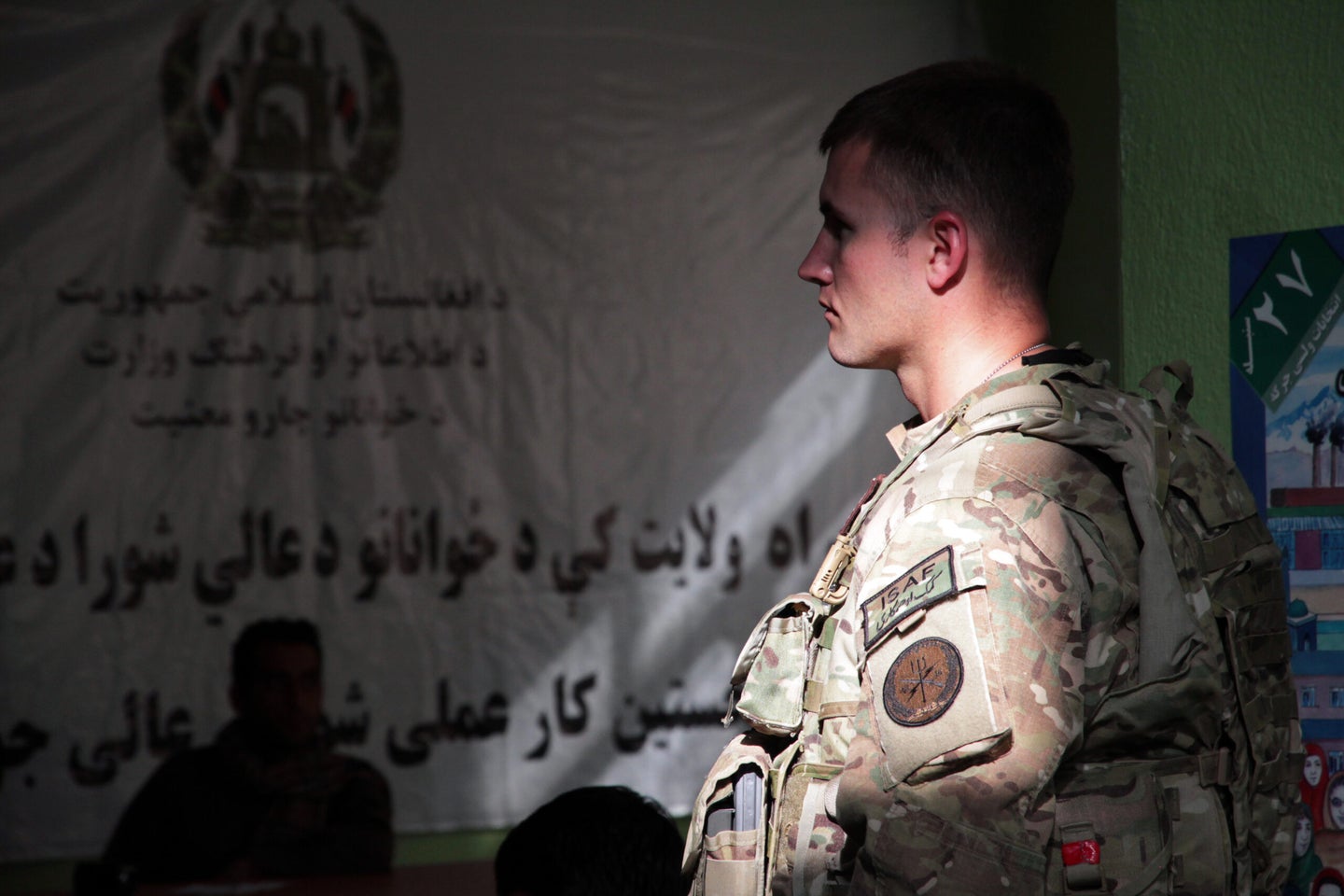I struggled with thoughts of suicide. Vulnerability and connection kept me alive
Looking someone in the eye as you tell them you care is when the real work of suicide prevention begins.

Editor’s Note: This is an opinion column. The thoughts expressed are those of the author.
Before I deployed to western Afghanistan in 2012, I warned my wife Jenny Lynne I might come back a different man.
“If there’s something off, or you can just tell that I’m different, get me help.”
I knew what it was like to be in the middle of a mental health crisis and to not be able to see the forest for the trees. At that point in our lives together I had a few years of sobriety under my belt and knew how scary that place could be – and how hard breaking down walls of illness and defense could be to get into healing and recovery.
“I’m sure I will fight you tooth-and-nail,” I said. “I may even hate you for it, but I know what it’s like and I won’t be able to see it…But I’m sure that that won’t happen.”
I don’t remember what she said, but I knew she would help me. Still, years later I realize how unfair it was for me to ask that of her.
Overall, our team’s deployment went well. Every member came home with ten fingers and ten toes. Our disparate hodgepodge of Army, Navy, Department of State, and USAID personnel executed our mission well in austere western Afghanistan, and in general, saw less direct fighting than U.S. units in the southern and eastern parts of the country. As members of the Provincial Reconstruction Team Farah our mission was one of governance and development, and while it wasn’t all roses, we weren’t “clearing” houses either.

When it was all over, the team I trained, lived, fought, worked, and experienced life with for that year was gone in the blink of an eye. Instead of redeploying as a unit like a warship or battalion, we began to disband in theater. For example, my fellow Navy individual augmentees and I took a pre-planned pit stop in Germany before we took flights to our primary duty stations across the U.S. A month later, I moved from Virginia to New York City for a new assignment. It was a jarring shift of realities from western Afghanistan to a midtown office building.
I took solace in long runs in the crisp fall air and tree-lined streets of our Glenbrook neighborhood in Stamford, Ct. It reminded me of past fall seasons in my home state of Michigan, and gave me a space to seek the peace and calm I was looking for. The candy-laden care packages eaten in Farah didn’t help me conquer the pavement, but the extra pounds they led to provided a new challenge to focus on as I tried to control my breathing and ignore my achy knees and ankles.
These runs gave me time to process the breakneck pace of the past three-plus years: marriage; first child born; promoting to second class petty officer; officer candidate school; aircraft carrier deployment; meeting child two on the pier; Afghanistan deployment; first time on shore duty as a family; first time spending more than a month with my children; first time living in the northeast. I was having a tough time squaring it all away, especially when it all looked great on paper. Having difficulty adjusting did not make sense to me.
On one of the runs in our new neighborhood, I struggled to move from step one. My legs felt like my toddler wet noodling in the grocery store when he didn’t get his way, and the only thing that kept my spirit up was Michael Franti’s song Life is Better With You. “…I’m not afraid to be alone, but being alone is better with you. Life is better with you.” While my feet moved down the sidewalk, my mind focused on finding a higher gear and completing the run. Just then, I noticed my face was wet. I began to cry. What the hell? Where’d that come from?
It was surprising and concerning.
When I got home, I told Jenny Lynne. At the very least she’d be intrigued. After all, I’m not one for crying over things large or small. A bit uncertain, I posted a quick comment on social media about the run. My usually responsive feed was quiet, save for the freaked-out notes calls from worried loved ones. Last time I’ll do that, I thought to myself.
Still, life overall seemed good. My Facebook feed was the envy of friends.. From my Midtown Manhattan perch, I supported outreach efforts for the Navy. It was a great job with tons of social engagement. I attended meetings and social events. Though I sometimes felt out of place, I tried to fit in by focusing on the mission. And it was exhilarating to explore the city that never sleeps. In our first few months there, we visited the Intrepid as a family, celebrated the Navy’s birthday with the NYPD, welcomed the USS New York in town for a port visit during the week of Veterans Day, and met with the Port Authority at the top of One World Trade before construction came to completion. New York was, is, and will always be a Navy town.

In no time, I made friends with members of the small active-duty community in the city, the veterans organizations I worked with, and most importantly within local recovery fellowships I’d relied on for years. But even as the horizon of post-deployment life took on New York proportion on the outside, it became clear that something was off inside my head and chest.
My legs were often fidgety, and I had difficulty sleeping. The smells from street food carts reminded me of Farah City. And my mind was often on edge. As I walked with Jenny Lynne to Grand Central to catch a train at Christmastime, I noticed someone following us on a quiet stretch of sidewalk out of the corner of my eye. I casually ushered the boys’ stroller and Jenny Lynne into a restaurant foyer “to see what was on the menu.” It was just long enough for a perceived threat to slide by.
So I kept running. It was my outlet. It grounded me in a world that was all new. My soles pounding the pavement were my first steps in working through the confusion and challenges swirling inside. And as much as I liked running in the Connecticut suburbs, I reveled in taking time at lunch to run through Midtown and up around Central Park. Best yet, I even lost a few pounds and felt good about it. The Big Apple assignment was going well.
But there was tension at home. We argued a lot, and I couldn’t understand why she was upset when I tried talking about my experience with the team on deployment. I wanted to look at pictures from deployment with Jenny Lynne while regaling the team’s accomplishments and challenges. I was desperate for an outlet, yet the awkwardness, frustration, and Jenny Lynne’s tears that usually concluded my best attempts to communicate with her were failing miserably. What was I missing? Why was she afraid?
Then there was the stress of fatherhood. One night my oldest son wouldn’t go to bed. The little bugger just could not get it. We went up the stairs. He came down the stairs. We went up. He came down. I finally lost it, ran to the steps, picked him up, and not so gracefully tossed him in his bed. I returned to a look on Jenny Lynne’s face I’ll never forget. She was disappointed and frightened. I was ashamed. What happened to the guy who was great with kids and had all the patience in the world for them?
Not long after, I underwent an annual military physical. Near the end, I completed a questionnaire about how I felt after deployment. Did I have any issues reintegrating? Recurring nightmares? How are you sleeping? Any thoughts of harming yourself? I wrote my answers with all the honesty of someone who was not going to stay in that office any longer than required.
After filling out the form, I met face-to-face with a doctor to go over my responses. I mentioned the minor chest pains, some minor readjustment challenges, and alluded to my years of experience in recovery. I reassured the doctor that I was on the road to good health.
The truth was that less than halfway through the questions I was fighting back tears. But the doctor didn’t press, and I wasn’t going to do anything that would keep me from going home that night to see my family. I’ve got this. I’ve been in a hole before and I know the way out, I told myself. There was life to live and work to be done.

At this same time, things were going well professionally, which bolstered my rattled nerves from the physical. However, my personal life was in a not-so-steady decline. Some days were great, and some days were awful, as residual anger, anxiety, and frustration mounted as I tried to sort it all out – largely on my own.
And so I kept running. The runs were cathartic…most of the time. But, I could no longer ignore the underlying feelings. I was angry. Pissed. Unsure of what was going on and afraid of the storm brewing under the surface. I could not stop arguing. I couldn’t find relief. Even the group of people that saved me before in recovery, didn’t seem safe. I kept showing up to recovery rooms, but couldn’t let my guard down. I knew the right things to say to keep up appearances, but the wheels started coming off. My fuse got shorter. Fights with my wife got worse. Darkness settled in. And my mind raced.
Eventually, it became more than my body could take. On Sept. 11, 2014 I was with my boss traveling back to New York City from a meeting at the Pentagon when I asked him if he would take over driving because my chest started to hurt. By the time we neared Manhattan, I curled up on the passenger seat in the fetal position feeling like I was going to die. It was the first of many debilitating panic attacks, though I didn’t recognize it at the time.

Around that time, I noticed something on a well-worn running path through our Stamford, Connecticut neighborhood. Most intriguing was the Exit 9 overpass over I-95. Not only did it provide a view of the WWE headquarters, but there was also no barrier to keep someone from jumping onto the interstate. I ran past it many times and thought, “Jumping would take all of this pain away, and JL wouldn’t have to deal with my bullshit anymore.” A few times I even stopped to take a hard look at the whizzing cars below.
Thankfully, I let that thought bounce around my head long enough to realize I needed to play the tape all the way through. As it did, three thoughts stopped me from jumping:
- Being hit by a vehicle would be very unpleasant.
- I could hurt someone else and their family when they hit me.
- My behavior would put my family through additional hell – perhaps worse than the one we were in.
While I played the tape through frequently, it did not stop the ruminating thoughts.
On other runs, train rides, or car trips I daydreamed about driving into something very solid, rationalizing I’d be the only one hurt. Another lie.
I didn’t want to die. I had a great wife, beautiful kids, and numerous opportunities in the city, but I couldn’t reconcile that and living in pain and confusion anymore. I was determined to find my own way out. I just wanted to take a long nap and have it all disappear.
I’d like to tell you that’s what happened. That I took a magic pill, woke up one day, and life was good. That wasn’t what happened.
What did happen was connection. It saved my life.
Even though I couldn’t find regular mental health treatment near my office residence, I found a new sponsor and started working with him. I laid it all on the table. We worked on the basics — honesty, open-mindedness, and willingness to take stock of what was going on. He didn’t give me a lecture, a list of things I screwed up or tell me that I was weak. Quite the opposite. He gave me hope that things would get better. Hope that if I just did what I needed to do one day at a time to be a better husband, a better father, and a better man by getting help, things would get better.
Though even with help and wisdom, the residual issues of post-traumatic stress required more specific treatment. I became willing to seek that treatment after a series of panic attacks, one of which left my dress uniform soaked in sweat and me lying prone on a cab floor in the city. Thankfully, I came across a pamphlet at work for a clinic a short walk from the office not long after.
And while my village helped me pull back from the edge, the work of true recovery hadn’t started. In the middle of treatment at Steven A. Cohen Military Family Center at NYU Langone Health and settling into the work with my sponsor we moved to California where I started 10 months of graduate school. It was awful personally yet professionally rewarding. My classes and classmates were great, but 12 or so hours a day of commute, class, and homework on top of trying to get treatment was nearly impossible for me and my family and it showed.
I was late for everything, irritable, and generally frustrated. Despite some improvements from NY, I was still in extremis. The dark thoughts came back as we fought to stay afloat as a family, and on one occasion – even though I pretended I was joking – I told my wife, “I should’ve jumped off of the Exit 9 overpass when I had the chance.”

Yet, I am convinced that were it not for my wife and kids, sponsor, friends in recovery, understanding leadership, and cognitive processing therapy, I would have taken my own life. The hard truth is that untreated post-traumatic stress injuries, military sexual trauma, mild-traumatic brain injury, anxiety, and depression for anyone – especially someone with a history of alcohol issues – can lead to poor outcomes.
In my experience, the solution to improving those outcomes comes in two parts;
- An individual’s willingness to be vulnerable and
- The attentiveness and willingness of those around them to connect.
Vulnerability and connection. Both are simple and neither are easy.
Both words and actions are enough to make my skin crawl and threaten to engage my gag reflex as I type. But, I know it’s in picking up the thousand-pound phone to chat with an old shipmate or battle buddy, grabbing coffee with someone, or looking someone in the eye as you tell him or her you care is when the real work of suicide prevention begins.
If you’re thinking about suicide, are worried about a friend or loved one, or would like emotional support, the Lifeline network is available 24/7 across the United States. Call the National Suicide Prevention Lifeline at 800-273-TALK (800-273-8255) to reach a trained counselor. Use that same number and press “1” to reach the Veterans Crisis Line.